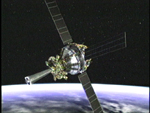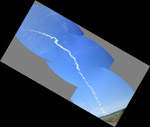WEEKLY HIGHLIGHTS FOR 14 MAY 2004:
GRAVITY PROBE B MISSION UPDATE
As of Day #24 of the mission, all spacecraft subsystems are functioning properly. The orbit is stable and meets our requirements for next month’s transition into the science phase of the mission, upon completion of the spacecraft initialization and orbit checkout. Furthermore, Gravity Probe B has successfully achieved several important milestones over the past week.
- All four gyroscopes have now been digitally suspended for over a week. At launch, the gyros were unsuspended. Once on orbit, each gyro was first suspended in analog mode, which provides coarse control of the gyro’s suspended position within its housing. Analog mode is used primarily as a backup or safe mode for suspending the gyros. Each gyro was then suspended digitally. The digital suspension mode is computer-controlled; it puts less torque on the gyros than analog mode and enables their position to be controlled with extremely high precision.
- At the end of last week, the Gravity Probe B team practiced Low Temperature Bakeout (LTB), in which discs of sintered titanium (very tiny titanium balls, smaller than cake sprinkles) are “warmed up” a few Kelvin, thereby attracting helium molecules to them. This process will remove any remaining helium from the gyro housings after full gyro spin-up. Last week’s practice LTB procedure had the added benefit of imparting a very small amount of spin-up helium gas to the gyros. Following the practice LTB, the SQUID gyro read-out data revealed that gyro #1, gyro #3, and gyro #4 were slowly spinning at 0.001, 0.002, and 0.010 Hz, respectively (1 Hz = 60 rpm). Amazingly, the Gyro Suspension Systems (GSS) were able to measure gas spin-up forces at the level of approximately 10 nano-newton (10-8 N). This means that the GP-B science team is able to interpret data from gyro spin rates four to five orders of magnitude smaller than what was planned for the GP-B science experiment.
- Earlier this week, the GP-B spacecraft flew “drag free” around gyro #1, maintaining translation control of the spacecraft to less than 500 nanometers. The term, “drag-free,” means that the entire spacecraft literally floats in its orbit—without any friction or drag—around one the gyros. Pairs of proportional micro thrusters put out a steady and finely controlled stream of helium gas, supplied by the Dewar, through its porous plug. Signals from the Gyro Suspension System (GSS) control the output of the micro thrusters, balancing the spacecraft around the selected gyro. The initial Drag Free Control (DFC) checkout lasted 20 minutes, as planned. Then, a two-hour DFC session was tested, during which the spacecraft roll rate was increased and then returned to its initial rate, maintaining drag-free status throughout the test. Achieving DFC indicates that we are on track to meet the science mission control requirements.
- Last, but not least, early this week, the Attitude & Translation Control system (ATC ) successfully used data from the on-board star sensors to point the spacecraft towards the guide star, IM Pegasi. This was the final step before initiating the dwell scan process, a series of increasingly accurate scans with the on-board telescope that enable the ATC to lock onto the guide star. Two days ago, the telescope’s shutter was opened, and a first dwell scan was completed. We are now in the final stages of repeating the dwell scan to home in on the guide star and lock onto it.
 The spacecraft is being controlled from the Gravity Probe B Mission Operations
Center, located here at Stanford University. The Stanford-NASA/MSFC-Lockheed
Martin
operations team is continuing to perform superbly.
The spacecraft is being controlled from the Gravity Probe B Mission Operations
Center, located here at Stanford University. The Stanford-NASA/MSFC-Lockheed
Martin
operations team is continuing to perform superbly.
Please Note: During the Initialization & Oribit Checkout (IOC) Phase of the GP-B mission, we will update this Web site and send out an email update once a week (usually on Thursday or Friday) to keep you appraised of our progress. From time to time, we may post and email extra updates, as warranted by mission events.
TRACKING THE GP-B SPACECRAFT
Find the Gravity Probe B satellite in the sky at NASA's satellite tracking web site. See where GP-B is with respect to the terminator (the day-night boundary on the Earth's surface), or just enter your zip code to see if GP-B might be over your neighborhood. The best time to look for it is usually at dusk.
Also, you can track the GP-B spacecraft on your Palm OS or Pocket PC Personal Digital Assistant (PDA), using either PocketSat (the original program) or PocketSat+ (a newer and more full-featured version) from Big Fat Tail Productions. Both products are PDA Shareware, so you can try them out for free. If you decide to use them, Big Fat Tail asks that you pay a nominal shareware fee.
LEARN MORE ABOUT THE GP-B GUIDE STAR, IM PEGASI
For an overview about why we chose IM Pegasi as our guide star, and its importance to the GP-B mission, see our Guide Star FAQ.
Also, the ETH Institute of Astronomy in Zurich, Switzerland, is working with the Harvard-Smithsonian Center for Astrophysics to provide detailed optical information about the GP-B guide star, IM Pegasi. You can find out about the ETH Institute's work in monitoring magnetic activity on IM Pegasi and the Doppler Imaging Technique used for this purpose on the ETH Institute of Astronomy GP-B Web page.
FOLLOW IOC ACTIVITIES AND LEARN MORE ABOUT GRAVITY PROBE B
 If you are interested in following the IOC procedures more closely, you'll find
a schedule and description of them on pages 12-14 of the Gravity Probe
B Launch Companion. This document also provides an overview and explanation
of the Gravity Probe B experiment and information about the spacecraft and
GP-B's amazing technologies. Click
here to download the GP-B Launch Companion in Adobe Acrobat PDF format.
(Please note: this file is 1.6 MB, so it may take awhile to download if you
have a
slow Internet connection.)
If you are interested in following the IOC procedures more closely, you'll find
a schedule and description of them on pages 12-14 of the Gravity Probe
B Launch Companion. This document also provides an overview and explanation
of the Gravity Probe B experiment and information about the spacecraft and
GP-B's amazing technologies. Click
here to download the GP-B Launch Companion in Adobe Acrobat PDF format.
(Please note: this file is 1.6 MB, so it may take awhile to download if you
have a
slow Internet connection.)
Photos: The first photo, showing the Delta II rocket and payload lifting off of the launch pad was taken by photographer Bill Hartenstein (http://www.ktb.net/~billmeco) . The second photo—actually three photos electronically "stitched together"— was taken by Marian Chuang, a systems enginee at Lockheed Martin Missles & Space Corporation. Tthe photo showing the spacecraft separating from the second stage rocket was extracted from NASA KSC's launch video. The final "photo" is actually a drawing of the GP-B spacecraft on orbit, as depicted in an animation created by NASA's Marshall Space Flight Center. Click on the thumbnails to view enlarged copies of these photos.
VIEW A VIDEO OF THE GP-B LAUNCH
 Click
here to view a 3 1/2 minute QuickTime video clip of the GP-B launch, produced
by the Stanford News Service. Please note that the video requires Quick Time to play.
Click here to
link to
download Quick Time.
Click
here to view a 3 1/2 minute QuickTime video clip of the GP-B launch, produced
by the Stanford News Service. Please note that the video requires Quick Time to play.
Click here to
link to
download Quick Time.![]()
FOLLOWING THE GP-B MISSION ON THE WEB
In addition to this Web site, here are some other Web sites that have information, photos, and video of the GP-B launch and mission.
- The ELV Missions Virtual Launch Center Web page on the John F. Kennedy Space Center Web site has information and several streaming video clips covering the GP-B mission. (You can view these video clips free of charge, but you will need to have either the Real Media Player or Windows Media Player installed on your computer to view them.)
- NASA's Marshall Space Flight Center Gravity Probe B.com Web page has a number of great photos from the GP-B launch, including photos of the spacecraft separation, as well as other information about Gravity Probe B.
- The Science @ NASA Web site, hosted by NASA's Marshall Space Flight Center, posts several stories each month about scientific research projects in which NASA is involved. This site currently features two general interest stories about Gravity Probe B: In search of Gravitomagnetism and A Pocket of Near Perfection. (In addition to the Web versions, these stories are also available in both plain text and streaming audio formats.)
- Photographer William G. Hartenstein's Web site has an extraordinary set of photos that he took on launch day.
- Another very comprehensive source of information about the GP-B launch is the Spaceflight Now Web site. This site contains an excellent photo gallery, as well as a number of Quicktime video clips of the launch. However, you have to become a subscriber to this site ($$$) in order to view the video clips.
GRAVITY PROBE B IN THE NEWS
Sunday evening, April 18th, a feature story about Gravity Probe B and principal investigator, Francis Everitt, aired on ABC World News Tonight. Click here to read a text version of the ABC News story. Also on April 18th, NPR's David Kestenbaum talked with GP-B's principal investigator, Francis Everitt on the program All Things Considered. On Friday, April 16th, Gravity Probe B Co-Principal Investigator, John Turneaure, was interviewed by Ira Flatow on NPR Talk of the Nation—Science Friday.
On Tuesday, April 13,2004, Gravity Probe B was the lead story in the Science section of the New York Times, and it was one of the front page stories in the San Jose Mercury News. (You'll need to register on the Web sites of these newspapers to view these stories online.) In addition, a story about GP-B appeared on the New Scientist Web on April 13, 2004.
The official pre-launch Gravity Probe B mission and science briefing was held on Friday, April 2, 2004 at 1:00 PM Eastern Daylight Time at NASA Headquarters in Washington, D.C. The participants in the briefing (pictured from left to right in the photo) were:

- Anne Kinney, Director of Astronomy/Physics Division, NASA Headquarters
- Rex Geveden, Program Manager, GP-B and Deputy Director, NASA's Marshall Space Flight Center in Huntsville, Alabama.
- Francis Everitt, GP-B Principal Investigator at Stanford University, Stanford, California
- Bradford Parkinson, GP-B Co-Principal Investigator at Stanford University, Stanford California
- Kip Thorne, Feynman Professor of Theoretical Physics, California Institute of Technology, Pasadena, California
You can view a Real Player streaming video of this briefing on the Kennedy Space Center GP-B Web site.
Following this press briefing, stories about Gravity Probe B appeared in a number of newspapers around the country. For example:
- The San Francisco Chronicle carried a front page story, which you can read online.
RECEIVE GRAVITY PROBE B WEEKLY HIGHLIGHTS BY EMAIL
If you are interested in automatically receiving these weekly highlights and other important GP-B mission information by email, you can subscribe to our Gravity Probe B Update email list by sending an email message to "majordomo@lists.Stanford.edu" with the command "subscribe gpb-update" in the body of the message (not in the Subject line). You can unsubscribe from this mailing list at any time by sending an email message to the same address with the command, "unsubscribe gpb-update" in the body of the message.
Previous Highlight
Index of Highlights


